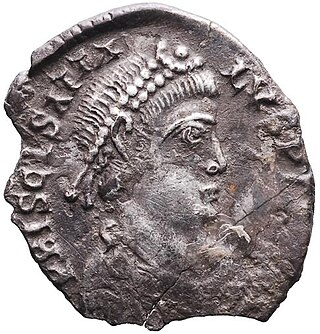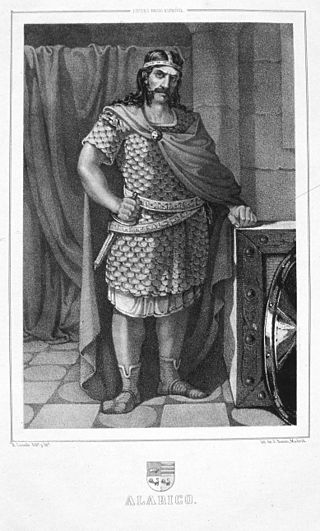The 470s decade ran from January 1, 470, to December 31, 479.
The 430s decade ran from January 1, 430, to December 31, 439.
The 480s decade ran from January 1, 480, to December 31, 489.
The 420s decade ran from January 1, 420, to December 31, 429.

Year 426 (CDXXVI) was a common year starting on Friday of the Julian calendar. At the time, it was known in Rome as the Year of the Consulship of Theodosius and Valentinianus. The denomination 426 for this year has been used since the early medieval period, when the Anno Domini calendar era became the prevalent method in Europe for naming years.

Year 409 (CDIX) was a common year starting on Friday of the Julian calendar. In the Roman Empire, it was known as the Year of the Consulship of Honorius and Theodosius. The denomination 409 for this year has been used since the early medieval period, when the Anno Domini calendar era became the prevalent method in Europe for naming years.

Year 466 (CDLXVI) was a common year starting on Saturday of the Julian calendar. At the time, it was known as the Year of the Consulship of Leo and Tatianus. The denomination 466 for this year has been used since the early medieval period, when the Anno Domini calendar era became the prevalent method in Europe for naming years.
Year 489 (CDLXXXIX) was a common year starting on Sunday of the Julian calendar. At the time, it was known as the Year of the Consulship of Probinus and Eusebius. The denomination 489 for this year has been used since the early medieval period, when the Anno Domini calendar era became the prevalent method in Europe for naming years.

Year 484 (CDLXXXIV) was a leap year starting on Sunday of the Julian calendar. At the time, it was known as the Year of the Consulship of Venantius and Theodoricus. The denomination 484 for this year has been used since the early medieval period, when the Anno Domini calendar era became the prevalent method in Europe for naming years.

Year 477 (CDLXXVII) was a common year starting on Saturday of the Julian calendar. At the time, it was known as the Year after the Consulship of Basiliscus and Armatus. The denomination 477 for this year has been used since the early medieval period, when the Anno Domini calendar era became the prevalent method in Europe for naming years.
Year 479 (CDLXXIX) was a common year starting on Monday of the Julian calendar. At the time, it was known as the Year of the Consulship of Zeno without colleague. The denomination 479 for this year has been used since the early medieval period, when the Anno Domini calendar era became the prevalent method in Europe for naming years.

Year 646 (DCXLVI) was a common year starting on Sunday of the Julian calendar. The denomination 646 for this year has been used since the early medieval period, when the Anno Domini calendar era became the prevalent method in Europe for naming years.

Year 300 (CCC) was a leap year starting on Monday of the Julian calendar. At the time, it was known as the Year of the Consulship of Constantius and Valerius. The denomination 300 for this year has been used since the early Middle Ages / Medieval period, when the Latin language term / abbreviation "Anno Domini" for the calendar era became the prevalent universal / worldwide method for naming and numbering years. First beginning in Europe at the end of the Roman Empire (after the split of the Western Roman Empire and Eastern Roman Empire in the early Middle Ages / Medieval period.

Zeno was Eastern Roman emperor from 474 to 475 and again from 476 to 491. His reign was plagued by domestic revolts and religious dissension, but was more successful on the foreign front. He is credited with further stabilizing the Eastern empire, while the Western Roman Empire fell following the deposition of Romulus Augustulus.

Aelia Verina was the Eastern Roman empress as the wife of Leo I. She was a sister of Emperor Basiliscus. Her daughter Ariadne also became empress. Verina was the maternal grandmother of Leo II.
Flavius Illus was a Roman general who played an important role in the reigns of the Eastern Emperors Zeno and Basiliscus.
Flavius Marcianus was a member of the Leonid dynasty. The son of the Western emperor Anthemius, Marcianus married Leontia, the daughter of the Eastern Roman emperor Leo I. He was consul twice, and in 479 unsuccessfully attempted to overthrow the emperor Zeno. After his capture he was forced to become a monk; he escaped and raised an army but was defeated and recaptured by Flavius Appalius Illus Trocundes. In 484, when the Isaurian general Illus revolted against Zeno, Marcianus was freed and Illus proclaimed him emperor, before deposing him in favour of Leontius.

Aelia Ariadne was Eastern Roman empress as the wife of Zeno and Anastasius I. She is venerated as a saint in the Eastern Orthodox Church, with her feast day falling on August 22.

Year 420 (CDXX) was a leap year starting on Thursday of the Julian calendar. At the time, it was known as the Year of the Consulship of Theodosius and Constantius. The denomination 420 for this year has been used since the early medieval period, when the Anno Domini calendar era became the prevalent method in Europe for naming years.










